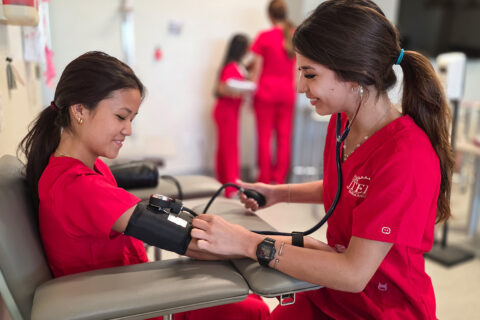Gain the technical knowledge and skills to safely fly and navigate aircraft. Learn the principles of aircraft design and performance, aircraft flight systems and controls, flight crew operations and procedures, radio communications, navigation procedures and systems, airways safety and traffic regulations, and governmental rules and regulations pertaining to piloting aircraft.
Eligibility
- Year 1:
- Grades 10-11
- Year 2:
- Successful completion of Year 1
- Year 3:
- Successful completion of Year 2
Number of Years to Complete this Program
3 years to complete
Things to Consider
- You will experience various aspects of the Air Transportation field.
- Air Transportation is not just about being a pilot. There are careers for people on the ground as well. For example, this could lead to careers in air traffic control, airport operations management, Unmanned Aircraft Systems (UAS) development/design, and Flight System, all of which require aviation knowledge and experience.
- Being able to fly a drone can be a career but it is mainly a skill that can be applied in a multitude of areas. The various fields that utilize UAS grow by the day.
- Aircraft Pilotry (both drones and airplanes) at this level requires an understanding of aerospace and aeronautical information required to legally and safely navigate our skies.
Direct Employment
- Drone Operator
- UAS Surveyor
- Aerial Photographer
- Videographer
- Inspector (solar, powerlines, roofing)
- Delivery
- Construction
- Agricultural Surveying
Jobs Available After Additional or Advanced Training
- Air Traffic Controller
- Airport Management
- Private Pilot
- Airline Pilot
- Flight Crew
- Ground Instructor
- Astronaut
- Airframe and Powerplant Mechanics
- Fighter Pilot
Locations
JTED @ The Bridges
3300 S. Park Ave.
Schedule Availability
- Year 1:
- Mondays & Wednesdays 4:15 to 6:45 p.m.
- Tuesdays & Thursdays 4:15 to 6:45 p.m.
- Also available during the daytime schedule @ Innovation Tech HS
- Year 2 & 3:
- Tuesdays & Thursdays 4:15 to 6:45 p.m.
- Also available during the daytime schedule @ Innovation Tech HS

Program Completion/Sequence
Year 1
As one of the fastest-growing segments of the aviation industry, drones now present countless career opportunities. Drone pilots are needed to operate small unmanned aircraft for things like aerial photography, aerial monitoring and surveillance, search and rescue missions, disaster response, and even package delivery and many more career opportunities.
- Students enrolling in this course will learn about Airspace classification and operating requirements, and flight restrictions affecting small unmanned aircraft operation. Aviation weather sources and effects of weather on small unmanned aircraft performance. Small unmanned aircraft loading and performance. Emergency procedures.
Students enrolled in this course will learn to operate commercial type industry drones with an introduction to photography, videography, creating 2D and 3D maps, Thermography, and understanding the Geographic Information Systems (GIS).
Year 2
This course will cover the basic knowledge required for a private pilot student to prepare for flight training and help prepare for the Private Pilot Airplane written exam. Students enrolling in this course will learn about Aerodynamics, Weather, Aircraft Components and Systems, Radio Communications, FAA Regulations, Navigation, Flight Planning, Aeromedical Factors and more.
- Throughout the year students will also complete flight simulator training that compliments the Private Pilot’s Ground Instruction being taught throughout the year.
Year 3
Students enrolled in this course will receive instruction on how to become a certified ground instructor. As a Basic Ground Instructor (BGI), students will be able to provide the ground instruction necessary for a sport, recreational, or private pilot certificate. BGIs can also endorse students to take the FAA knowledge tests for each of those certificates, as well as provide the ground school portion of a flight review.
- Students in this course will use all the aeronautical knowledge they learned in Year 1 and 2, and will learn about the fundamentals of Instruction which include:
- The learning process
- Elements of effective teaching
- Student evaluation and testing
- Course development
- Lesson planning
- Classroom training techniques
Certifications
- Year 1:
- FAA Recreational UAS Safety Test (TRUST) – Completion Certificate
- FAA Remote Pilot Commercial License (Part 107 sUAS)
- Must be 16 years of age prior to testing
- Year 2:
- FAA Written Exam (required component of Private Pilot’s license)
- Year 3:
- FAA Ground Instructor Commercial License
- The FAA will award the student this rating once the applicant turns 18 years old
- FAA Ground Instructor Commercial License
Work Based Learning Requirements
Students who complete one or more years of the program and meet the eligibility requirements may have the opportunity to participate in our Internship Program.
Credits
1/Year
Instructor
- Ken James
- Salvatore Fiorella

More Information
Uniform
- JTED program t-shirt (evening programs)
Beneficial Classes to Take in High School
Academic Classes
- Math
- Physics
- Science
CTE Classes
- Engineering
- Robotics
- Computer Science





